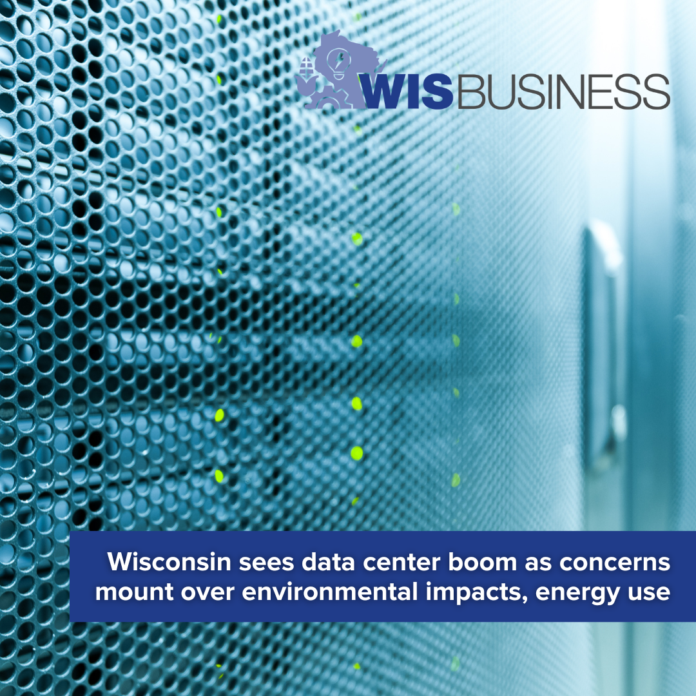Wisconsin has become a hotbed of data center activity over the past few years as some of the biggest names in the business rush to take advantage of accessible water, affordable electricity and the state’s cool climate.
At least 47 data centers are currently up and running or proposed in Wisconsin, according to Data Center Map. But experts say there could be more because some companies obscure their plans by entering into non-disclosure agreements and creating shell companies. The state’s vast supply of water, relatively affordable and available electricity, available land and colder climate to assist with cooling needs are attractive, experts add.
Past Wisconsin Tech Council President Tom Still said Wisconsin has been attracting a lot of data center activity lately because there’s a lot of available land, utilities have historically been reliable and the state’s construction industry is skilled and large enough to build the vast structures.
“I think that just finding the kinds of people who can work in these data centers is not as much of a challenge as it might be in other places, because there are computer science schools and tech colleges and other places that can help fill those jobs,” he added.
Wisconsin ranks behind other Midwestern states, though. Michigan has at least 57 data centers; Minnesota, 72; Indiana, 74; Iowa, 104; and Illinois, 222, according to DCM.
Almost half of those in Wisconsin, 21, are located in the Milwaukee area, with 11 in the Madison area and five in and around Kenosha. The rest are scattered around central Wisconsin, a DCM map shows.
DCM, founded in 2007, sources information from data center operators, end-users, through manual sourcing and more.
But many Wisconsinites, including prominent figures such as comedian Charlie Berens, have raised concerns about the environmental impact the data center boom will have. People are also concerned about rising utility costs associated with the increased demand on the power grid. A study by Carnegie Mellon University and North Carolina State University found data centers are expected to grow electricity bills by as much as 25% in certain regions of the country.
What is a data center, and where are they?
Technically, a data center can be any room, building or facility housing information technology infrastructure for building, running and developing applications and services, according to IBM. Under that definition, anything from an in-house server room in an office to the more than 7 million square-feet of space at The Citadel Campus in Reno, Nevada, could be considered a data center.
One of the data centers proposed in Wisconsin is the $8 billion, 672-acre Vantage data center near Port Washington. The Port Washington Common Council in August approved a development deal to move forward with the project’s Denver-based company. But the Vantage project will only be a small portion of the larger 1,900-acre data center campus that Cloverleaf Infrastructure is planning.
The Washington-based developer touts “delivering clean-powered, ready-to-build projects,” but hasn’t announced who else will occupy the campus.
Aside from the difficulty in figuring out exactly how many and where all the data centers and projects are, it’s difficult to quantify how large each project is. DCM reports out of the 10,844 data centers it’s tracking, only 3,836 include how much power in megawatts they use, and just 1,812 include total building size.
Another large data center investment, at least by dollar amount, comes from Microsoft’s more than $7 billion plan to build two data centers at the former Foxconn site in Racine County’s Mount Pleasant.
That plan, which includes at least 1,575 acres, doesn’t include the two other recent Microsoft data center plans in nearby Caledonia and Kenosha. Microsoft in January purchased 240 acres in Kenosha. The Caledonia Plan Commission Sept. 29 approved amending a land-use plan to rezone a 245-acre site, but less than two weeks later Microsoft announced it was backing out of its Caledonia effort, citing “community concerns.”
Microsoft also announced it still plans to find another site in southeastern Wisconsin instead of Caledonia.
Those projects, if the company’s Caledonia replacement is the same size, would bring Microsoft’s total footprint to more than 2,000 acres of data centers in southeastern Wisconsin, but they’re not the only company vying to occupy such large tracts of land.
Some data centers, like the Wells Building, owned by 1547 Critical Systems Realty, are much less conspicuous. The structure, a 15-story building and one of Milwaukee’s oldest skyscrapers, has occupied the same lot in the heart of downtown since 1901.
The 124-year-old structure has long been a communication hub and houses more than 30 carriers such as AT&T, Time Warner and Verizon. As communication technology has changed, so too has the building’s infrastructure. Under 1547’s ownership, the Wells Building now boasts up to 12 megawatts of building capacity power and 5,000 square feet of currently available data center space.
But that power capacity pales in comparison to large-scale data centers.
Environmental impact
Cloverleaf boasts it will be ready to deliver 3.5 gigawatts of power by 2030. That’s nearly 300 times as much as the Wells Building.
Microsoft’s first Mount Pleasant project and the Vantage project combined will require roughly 3.9 gigawatts of power. That’s not including Microsoft’s second Mount Pleasant project.
Clean Wisconsin in an analysis of the two projects found that’s enough power for roughly 4.3 million Wisconsin homes, more than the roughly 2.8 million housing units that currently exist in the state.
Amy Barrilleaux, Clean Wisconsin’s communications director, also said the speed at which companies are forging ahead makes it difficult to quantify the environmental impact they will have. But it’s clear there will be lasting effects, she added.
“It is going to push Wisconsin into a place where we’re not any closer to our clean energy goals, our climate goals, in a summer when we’ve had terrible smoke and severe flooding,” she said. “And so I think we’re seeing, just in terms of the sheer demand of energy that these data centers are going to need, we’re seeing how big that is.”
Water consumption is another major concern, Barrilleaux said.
Many past data center designs required continual water consumption, pumping it into cooling systems to reduce the heat of technology and then pumping it right back out of the facility again. Newer designs tend to use closed-loop designs, which are filled with water that circulates through the technology and then is cooled back down through large radiators, similar to a car’s radiator system.
But the closed-loop design is a trade-off, Barrilleuz said, adding “those systems are more energy intensive.”
“So it’s important to understand that 70% of water withdrawals in Wisconsin are for power generation in this state,” she said. “So we do not have a good understanding of what the true water impact is going to be in Wisconsin, because we don’t, for most of these projects, know how much energy they’re going to use. We don’t know how many gallons of water they’re going to use on site. We don’t know exactly where they’re going to be getting this water from.”
Dan Diorio, vice president of the Data Center Coalition, said water usage by data centers in Virginia, the nation’s data center hub, is sustainable, and the state’s regulations help ensure things stay that way. He also argued the industry “is committed to responsible water use, and it prioritizes efficient water practices and responsible management across operations and development.”
“Data centers are also actively investing in and deploying innovations, such as waterless cooling systems, closed-loop systems, and the use of recycled or reclaimed water,” Diorio said. “The industry also engages in water and watershed conservation and restoration projects in local communities and globally.”
Wisconsin Tech Council President Tom Still also said it’s worth keeping an eye on how much power and water data centers will consume, as well as the ability to meet the demands without generating a large amount of pollution.
See the full story in the Friday REPORT.






